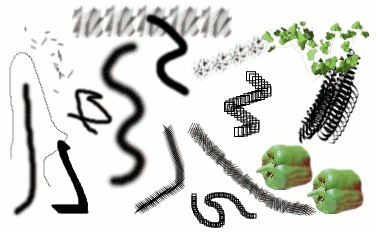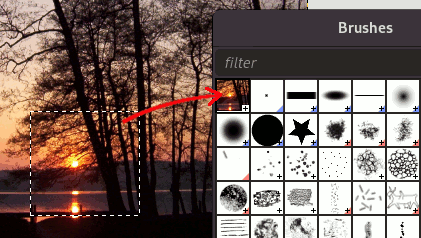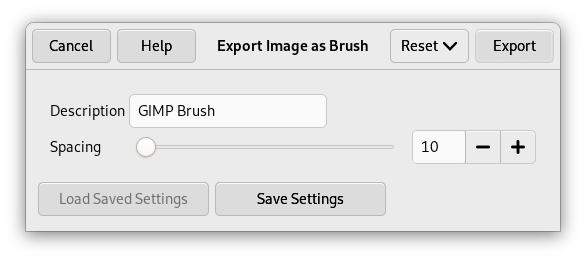Figura 7.15. Exemplo de pinceladas

Uma série de exemplos de pinceladas pintadas usando diferentes pincéis do conjunto fornecido com o GIMP. Todos foram pintadas usando a ferramenta Pincel.
A brush is a pixmap or set of pixmaps used for painting. GIMP includes a set of Paint Tools, which not only perform operations that you would normally think of as painting, but also operations such as erasing, copying, smudging, lightening or darkening, etc. All of the paint tools, except the ink tool, use the same set of brushes. The brush pixmaps represent the marks that are made by single “touches” of the brush to the image. A brush stroke, usually made by moving the pointer across the image with the mouse button held down, produces a series of marks spaced along the trajectory, in a way specified by the characteristics of the brush and the paint tool being used.
Pincéis podem ser selecionados clicando em um ícone no diálogo Pincéis. O pincel atual do GIMP é mostrado na área Pincel/Textura/Degradê da caixa de ferramentas (se essa área estiver ativa). Clicar no símbolo do pincel é uma forma de ativar o diálogo de pincéis.
Quando você instala o GIMP, ele vem com uma série de pincéis básicos, além de uns poucos bizarros que servem principalmente para lhe dar exemplos de que é possível (por exemplo, o pincel pepper ("pimentão") na ilustração). Você também pode criar novos pincéis, ou baixá-los e instalá-los, de modo que o GIMP irá reconhecê-los.
O GIMP pode usar vários tipos de pincéis. Todos eles, no entanto, são usados da mesma forma, e na maioria dos casos você não precisa se preocupar com as diferenças quando você pintar com eles. Esses são os tipos de pincel:
- Pinceis Comuns
-
Most of the brushes supplied with GIMP fall into this category. They are represented in the Brushes dialog by grayscale pixmaps. When you paint using them, the current foreground color (as shown in the Color Area of the Toolbox) is substituted for black, and the pixmap shown in the Brushes dialog represents the mark that the brush makes on the image.
To create such a brush: create a grayscale image in gray levels, where black is fully visible, white is transparent, with gray levels in between. Do not use transparency for these brushes. Save it with the .gbr extension. Click on the Refresh button in the Brushes Dialog to get it in preview without it being necessary to restart GIMP.
- Pincéis coloridos
-
Pincéis nesta categoria são representados por imagens coloridas no diálogo de pincéis. Eles podem ser fotos, texto ou qualquer imagem. Quando você pinta com eles, as cores são usadas como mostradas, a cor de frente atual não entra em jogo. Para tudo o mais, eles funcionam da mesma maneira que pincéis comuns.
To create such a brush, create a small RGBA image:
Select → from the main menu.
In the Advanced Options, set for example the Color space to RGB color and set Fill with to Transparency.
Draw your image. Contrary to grayscale brushes, transparent areas here will be drawn transparent.
Select → from the main menu to first save your image as an
.xcffile to keep its properties.Select → from the main menu to export the image as a brush with the
.gbrextension.In the Brushes Dialog, click on the button
.
Your brush appears among the other brushes. You can use it immediately, without restarting GIMP.
![[Dica]](images/tip.png)
Dica Quando você faz uma cópia ou um corte em uma seleção, você vê o conteúdo da área de transferência (que é a seleção) na primeira posição no diálogo de pincéis. E você pode usá-lo dirtamente para pintura, como qualquer outro pincel.
- Mangueiras ou tubos de imagem
-
Pinceis nesta categoria podem fazer mais de um tipo de marca em uma imagem. Eles são indicados por pequenos triângulos vermelhos no canto inferior direito da miniatura do pincel na caixa de diálogo de pincéis. Eles são às vezes chamados "pincéis animados", pois as marcas mudam conforme você traça uma pincelada. Em princípio, os “pincéis de mangueira de imagens” podem ser muito sofisticados, principalmente se utilizar uma mesa digitalizadora, mudando a forma que é impressa em uma função do ângulo, da pressão e da inclinação da caneta utilizadas na pintura, etc... É possível que todas as possibilidades nunca tenham sido realmente exploradas a fundo. Os pincéis animados fornecidos com o GIMP são relativamente simples (mas ainda assim muito úteis). A partir GIMP-2,8, com a introdução de dinâmicas de pintura, se tornou bem mais simples personalizar muitas das coisas que só seriam possíveis com um pincel animado muito sofisticado no GIMP (por exemplo, um pincel que pode mudar de cor de acordo com a direção da pincelada e tamanho de acordo com a velocidade de pintura). No entanto, também abriu a possibilidade de se combinar um pincel animado sofisticado e dinâmicas de pinturas personalizadas. Você pode ser um pioneiro nessa fronteira.
You will find an example on how to create such brushes in Animated brushes
- Pinceis paramétricos
-
Estes são pincéis criados com o Editor de pincel, que permite gerar uma grande variedade de formas de pincel usando uma interface gráfica simples. Um bom recurso de pincéis paramétricos é que eles são redimensionáveis sem perda de qualidade. É possível, utilizando diálogo de , fazer com que teclas de atalho ou mouse ou girar a rodinha do mouse façam o pincel atual tornar-se maior ou menor. Por padrão, as ações de aumentar e diminuir o tamanho do pincel estão vinculadas respectivamente as teclas “]” e “[”.
Todas os pincéis têm um tamanho variável. Na caixa de opções de todas as ferramentas de pintura, existe uma barra para aumentar ou reduzir o tamanho do pincel ativo. Você pode fazer isso diretamente na janela da imagem se você definiu corretamente a rodinha do mouse, ou com as teclas de atalho, veja Variando o tamanho do pincel.
Além do mapa de pixels do pincel, cada pincel do GIMP tem uma outra propriedade importante: o Espaçamento do pincel. Ele representa a distância entre as marcas de pincel consecutivas quando uma pincelada contínua é pintada. Cada pincel tem um valor padrão atribuído para o espaçamento, mas ele também pode ser modificado usando o diálogo de pincéis.
![[Nota]](images/note.png)
|
Nota |
|---|---|
|
GIMP can use MyPaint brushes. Please refer to Secção 3.11, “MyPaint Brush” for more information. |
![[Nota]](images/note.png)
|
Nota |
|---|---|
|
There is a quick method to add a new brush: Secção 5.4, “Creating a brush quickly”. |
To add a new brush, after either creating or downloading it, you need to save it in a format GIMP can use. The brush file needs to be placed in the GIMP's brush search path, so that GIMP is able to index and display it in the Brushes dialog. You can hit the button, which reindexes the brush directory. GIMP uses three file formats for brushes:
- GBR
-
The
.gbr("gimp brush") format is used for ordinary and color brushes. You can convert many other types of images, including many brushes used by other programs, into GIMP brushes by opening them in GIMP and saving them with file names ending in.gbr. This brings up a dialog box in which you can set the default Spacing for the brush.A technical specification of the GBR file format can be found on developer.gimp.org.
- GIH
-
The
.gih("gimp image hose") format is used for animated brushes. These brushes are constructed from images containing multiple layers: each layer may contain multiple brush-shapes, arranged in a grid. When you save an image as a.gihfile, a dialog comes up that allows you to describe the format of the brush. See Secção 5.2, “Creating animated brushes” for more information about the dialog.A technical specification of the GIH file format can be found on developer.gimp.org.
- VBR
-
The
.vbrformat is used for parametric brushes, i. e., brushes created using the Brush Editor. There is really no other meaningful way of obtaining files in this format. - MYB
-
The
.mybformat is used for MyPaint brushes. Please refer to Secção 3.11, “MyPaint Brush” for more information.
To make a brush available, place it in one of the folders in GIMP's brush
search path. By default, the brush search path includes two folders, the
system brushes folder, which you should not use or
alter, and the brushes folder inside your personal
GIMP directory. You can add new folders to the brush search path using the
Brush Folders
page of the Preferences dialog. Any GBR, GIH, or VBR file included in a
folder in the brush search path will show up in the Brushes dialog the
next time you start GIMP, or as soon as you press the
button in the Brushes dialog.
![[Nota]](images/note.png)
|
Nota |
|---|---|
|
When you create a new parametric brush using the Brush Editor, it
is automatically saved in your personal
|
There are a number of web sites with downloadable collections of GIMP brushes. Rather than supplying a list of links that will soon be out of date, the best advice is to do a search with your favorite search engine for “GIMP brushes”. There are also many collections of brushes for other programs with painting functionality. Some can be converted easily into GIMP brushes, some require special conversion utilities, and some cannot be converted at all. Most fancy procedural brush types fall into the last category. If you need to know, look around on the web, and if you don't find anything, look for an expert to ask.





